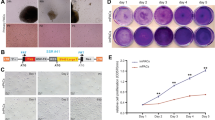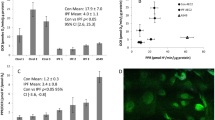Abstract
In pulmonary research, temperature-sensitive immortalized cell lines derived from the lung of the “immortomouse” (H-2kb-tsA58 transgenic mouse), such as C22 club cells and T7 alveolar epithelial cells type II (AECII), are frequently used cell culture models to study CC10 metabolism and surfactant synthesis. Even though peroxisomes are highly abundant in club cells and AECII and might fulfill important metabolic functions therein, these organelles have never been investigated in C22 and T7 cells. Therefore, we have characterized the peroxisomal compartment and its associated gene transcription in these cell lines. Our results show that peroxisomes are highly abundant in C22 and T7 cells, harboring a common set of enzymes, however, exhibiting specific differences in protein composition and gene expression patterns, similar to the ones observed in club cells and AECII in situ in the lung. C22 cells contain a lower number of larger peroxisomes, whereas T7 cells possess more numerous tubular peroxisomes, reflected also by higher levels of PEX11 proteins. Moreover, C22 cells harbor relatively higher amounts of catalase and antioxidative enzymes in distinct subcellular compartments, whereas T7 cells exhibit higher levels of ABCD3 and plasmalogen synthesizing enzymes as well as nuclear receptors of the PPAR family. This study suggest that the C22 and T7 cell lines of the immortomouse lung are useful models to study the regulation and metabolic function of the peroxisomal compartment and its alterations by paracrine factors in club cells and AECII.







Similar content being viewed by others
References
Baumgart E (1997) Application of in situ hybridization, cytochemical and immunocytochemical techniques for the investigation of peroxisomes. A review including novel data. Robert Feulgen Prize Lecture 1997. Histochem Cell Biol 108:185–210
Baumgart E, Volkl A, Hashimoto T, Fahimi HD (1989) Biogenesis of peroxisomes: immunocytochemical investigation of peroxisomal membrane proteins in proliferating rat liver peroxisomes and in catalase-negative membrane loops. J Cell Biol 108:2221–2231
Baumgart E, Vanhooren JC, Fransen M, Marynen P, Puype M, Vandekerckhove J, Leunissen JA, Fahimi HD, Mannaerts GP, van Veldhoven PP (1996) Molecular characterization of the human peroxisomal branched-chain acyl-CoA oxidase: cDNA cloning, chromosomal assignment, tissue distribution, and evidence for the absence of the protein in Zellweger syndrome. Proc Natl Acad Sci USA 93:13748–13753
Chae HZ, Robison K, Poole LB, Church G, Storz G, Rhee SG (1994) Cloning and sequencing of thiol-specific antioxidant from mammalian brain: alkyl hydroperoxide reductase and thiol-specific antioxidant define a large family of antioxidant enzymes. Proc Natl Acad Sci USA 91:7017–7021
Chambers TJ, Owens JM, Hattersley G, Jat PS, Noble MD (1993) Generation of osteoclast-inductive and osteoclastogenic cell lines from the H-2KbtsA58 transgenic mouse. Proc Natl Acad Sci USA 90:5578–5582
Chang CC, South S, Warren D, Jones J, Moser AB, Moser HW, Gould SJ (1999) Metabolic control of peroxisome abundance. J Cell Sci 112:1579–1590
Danscher G (1981) Light and electron microscopic localization of silver in biological tissue. Histochemistry 71:177–186
deMello DE, Mahmoud S, Padfield PJ, Hoffmann JW (2000) Generation of an immortal differentiated lung type-II epithelial cell line from the adult H-2K(b)tsA58 transgenic mouse. In Vitro Cell Dev Biol Anim 36:374–382
Demello DE, Mahmoud S, Ryerse J, Hoffmann JW (2002) Generation and characterization of a conditionally immortalized lung clara cell line from the H-2kb-tsA58 transgenic mouse. In Vitro Cell Dev Biol Anim 38:154–164
Diglio CA, Kikkawa Y (1977) The type II epithelial cells of the lung. IV. Adaption and behavior of isolated type II cells in culture. Lab Invest 37:622–631
Fahimi HD, Beier K, Lindauer M, Schad A, Zhan J, Pill J, Rebel W, Volkl A, Baumgart E (1996) Zonal heterogeneity of peroxisome proliferation in rat liver. Ann N Y Acad Sci 804:341–361
Ferdinandusse S, Jimenez-Sanchez G, Koster J, Denis S, Van Roermund CW, Silva-Zolezzi I, Moser AB, Visser WF, Gulluoglu M, Durmaz O, Demirkol M, Waterham HR, Gokcay G, Wanders RJ, Valle D (2015) A novel bile acid biosynthesis defect due to a deficiency of peroxisomal ABCD3. Hum Mol Genet 24:361–370
Grant P, Ahlemeyer B, Karnati S, Berg T, Stelzig I, Nenicu A, Kuchelmeister K, Crane DI, Baumgart-Vogt E (2013) The biogenesis protein PEX14 is an optimal marker for the identification and localization of peroxisomes in different cell types, tissues, and species in morphological studies. Histochem Cell Biol 140:423–442
Hiltunen JK, Filppula SA, Koivuranta KT, Siivari K, Qin YM, Hayrinen HM (1996) Peroxisomal beta-oxidation and polyunsaturated fatty acids. Ann N Y Acad Sci 804:116–128
Immenschuh S, Baumgart-Vogt E (2005) Peroxiredoxins, oxidative stress, and cell proliferation. Antioxid Redox Signal 7:768–777
Islinger M, Lüers GH, Zischka H, Ueffing M, Völkl A (2006) Insights into the membrane proteome of rat liver peroxisomes: microsomal glutathione-S-transferase is shared by both subcellular compartments. Proteomics 6:804–816
Issemann I, Green S (1990) Activation of a member of the steroid hormone receptor superfamily by peroxisome proliferators. Nature 347:645–650
Jat PS, Noble MD, Ataliotis P, Tanaka Y, Yannoutsos N, Larsen L, Kioussis D (1991) Direct derivation of conditionally immortal cell lines from an H-2kb-tsA58 transgenic mouse. Proc Natl Acad Sci USA 88:5096–5100
Karnati S, Baumgart-Vogt E (2008) Peroxisomes in mouse and human lung: their involvement in pulmonary lipid metabolism. Histochem Cell Biol 130:719–740
Karnati S, Baumgart-Vogt E (2009) Peroxisomes in airway epithelia and future prospects of these organelles for pulmonary cell biology. Histochem Cell Biol 131:447–454
Karnati S, Luers G, Pfreimer S, Baumgart-Vogt E (2013) Mammalian SOD2 is exclusively located in mitochondria and not present in peroxisomes. Histochem Cell Biol 140:105–117
Kovacs WJ, Olivier LM, Krisans SK (2002) Central role of peroxisomes in isoprenoid biosynthesis. Prog Lipid Res 41:369–391
Lakatos HF, Thatcher TH, Kottmann RM, Garcia TM, Phipps RP, Sime PJ (2007) The role of PPARs in lung fibrosis. PPAR Res 2007:71323
Li X, Gould SJ (2002) PEX11 promotes peroxisome division independently of peroxisome metabolism. J Cell Biol 156:643–651
Li X, Baumgart E, Morrell JC, Jimenez-Sanchez G, Valle D, Gould SJ (2002) PEX11 beta deficiency is lethal and impairs neuronal migration but does not abrogate peroxisome function. Mol Cell Biol 22:4358–4365
Mannaerts GP, Van Veldhoven PP (1993) Peroxisomal beta-oxidation. Verh K Acad Geneeskd Belg 55:45–78
Martinez M (1996) Docosahexaenoic acid therapy in docosahexaenoic acid-deficient patients with disorders of peroxisomal biogenesis. Lipids 31(Suppl):S145–S152
Mason RJ, Dobbs LG, Greenleaf RD, Williams MC (1977) Alveolar type II cells. Fed Proc 36:2697–2702
Michael LF, Lazar MA, Mendelson CR (1997) Peroxisome proliferator-activated receptor gamma1 expression is induced during cyclic adenosine monophosphate-stimulated differentiation of alveolar type II pneumonocytes. Endocrinology 138:3695–3703
Mundel P, Reiser J, Zuniga Mejia Borja A, Pavenstadt H, Davidson GR, Kriz W, Zeller R (1997) Rearrangements of the cytoskeleton and cell contacts induce process formation during differentiation of conditionally immortalized mouse podocyte cell lines. Exp Cell Res 236:248–258
Nenicu A, Lüers GH, Kovacs W, Otte D, Zimmer A, Bergmann M, Baumgart-Vogt E (2007) Peroxisomes in human and mouse testis: differential expression of peroxisomal proteins in germ cells and distinct somatic cell types of the testis. Biol Reprod 77:1060–1072
Newman GR, Jasani B, Williams ED (1983) A simple post-embedding system for the rapid demonstration of tissue antigens under the electron microscope. Histochem J 15:543–555
Petrik P (1971) Fine structural identification of peroxisomes in mouse and rat bronchiolar and alveolar epithelium. J Histochem Cytochem 19:339–348
Polvani S, Tarocchi M, Galli A (2012) PPARgamma and oxidative stress: con(beta) catenating NRF2 and FOXO. PPAR Res 2012:641087
Ryerse JS, Hoffmann JW, Mahmoud S, Nagel BA, deMello DE (2001) Immunolocalization of CC10 in Clara cells in mouse and human lung. Histochem Cell Biol 115:325–332
Schneeberger EE (1972) A comparative cytochemical study of microbodies (peroxisomes) in great alveolar cells of rodents, rabbit and monkey. J Histochem Cytochem 20:180–191
Schrader M, Reuber BE, Morrell JC, Jimenez-Sanchez G, Obie C, Stroh TA, Valle D, Schroer TA, Gould SJ (1998) Expression of PEX11beta mediates peroxisome proliferation in the absence of extracellular stimuli. J Biol Chem 273:29607–29614
Shannon JM, Jennings SD, Nielsen LD (1992) Modulation of alveolar type II cell differentiated function in vitro. Am J Physiol 262:L427–L436
Shimizu M, Takeshita A, Tsukamoto T, Gonzalez FJ, Osumi T (2004) Tissue-selective, bidirectional regulation of PEX11 alpha and perilipin genes through a common peroxisome proliferator response element. Mol Cell Biol 24:1313–1323
Simon DM, Arikan MC, Srisuma S, Bhattacharya S, Tsai LW, Ingenito EP, Gonzalez F, Shapiro SD, Mariani TJ (2006) Epithelial cell PPAR[gamma] contributes to normal lung maturation. FASEB J 20:1507–1509
Sosenko IR, Innis SM, Frank L (1991) Intralipid increases lung polyunsaturated fatty acids and protects newborn rats from oxygen toxicity. Pediatr Res 30:413–417
Spite M, Serhan CN (2010) Novel lipid mediators promote resolution of acute inflammation: impact of aspirin and statins. Circ Res 107:1170–1184
Tölle A, Meier W, Rüdiger M, Hofmann KP, Rüstow B (2002) Effect of cholesterol and surfactant protein B on the viscosity of phospholipid mixtures. Chem Phys Lipids 114:159–168
Untergasser A, Cutcutache I, Koressaar T, Ye J, Faircloth BC, Remm M, Rozen SG (2012) Primer3—new capabilities and interfaces. Nucleic Acids Res 40:e115
Visser WF, van Roermund CW, Ijlst L, Waterham HR, Wanders RJ (2007) Metabolite transport across the peroxisomal membrane. Biochem J 401:365–375
Wang XY, Keefe KM, Jensen-Taubman SM, Yang D, Yan K, Linnoila RI (2012) Novel method for isolation of murine clara cell secretory protein-expressing cells with traces of stemness. PLoS One 7:e43008
Whitehead RH, VanEeden PE, Noble MD, Ataliotis P, Jat PS (1993) Establishment of conditionally immortalized epithelial cell lines from both colon and small intestine of adult H-2kb-tsA58 transgenic mice. Proc Natl Acad Sci USA 90:587–591
Wiese S, Gronemeyer T, Ofman R, Kunze M, Grou CP, Almeida JA, Eisenacher M, Stephan C, Hayen H, Schollenberger L, Korosec T, Waterham HR, Schliebs W, Erdmann R, Berger J, Meyer HE, Just W, Azevedo JE, Wanders RJ, Warscheid B (2007) Proteomics characterization of mouse kidney peroxisomes by tandem mass spectrometry and protein correlation profiling. Mol Cell Proteomics 6:2045–2057
Winkelmann A, Noack T (2010) The Clara cell: a “Third Reich eponym”? Eur Respir J 36:722–727
Wong CJ, Akiyama J, Allen L, Hawgood S (1996) Localization and developmental expression of surfactant proteins D and A in the respiratory tract of the mouse. Pediatr Res 39:930–937
Xiao Y, Karnati S, Qian G, Nenicu A, Fan W, Tchatalbachev S, Holand A, Hossain H, Guillou F, Luers GH, Baumgart-Vogt E (2012) Cre-mediated stress affects sirtuin expression levels, peroxisome biogenesis and metabolism, antioxidant and proinflammatory signaling pathways. PLoS One 7:e41097
Yamamoto K, Fahimi HD (1987) Three-dimensional reconstruction of a peroxisomal reticulum in regenerating rat liver: evidence of interconnections between heterogeneous segments. J Cell Biol 105:713–722
Zoeller RA, Lake AC, Nagan N, Gaposchkin DP, Legner MA, Lieberthal W (1999) Plasmalogens as endogenous antioxidants: somatic cell mutants reveal the importance of the vinyl ether. Biochem J 338(Pt 3):769–776
Acknowledgments
The authors thank Elke Richter, Andrea Textor, Bianca Pfeiffer and Karina Greve for excellent technical assistance. Furthermore, we would like to thank Profs. Denis I. Crane, Stephen J. Gould, Paul P. Van Veldhoven, Alfred Völkl and Nancy Bravermann for providing us with some antibodies (see Table 1). Our study was supported by performance-related resource allocation funds (LOM = Leistungsorientierte Mittel) of the Medical Faculty of the Justus Liebig University Giessen, Germany.
Author information
Authors and Affiliations
Corresponding author
Electronic supplementary material
Below is the link to the electronic supplementary material.
Rights and permissions
About this article
Cite this article
Karnati, S., Palaniswamy, S., Alam, M.R. et al. C22-bronchial and T7-alveolar epithelial cell lines of the immortomouse are excellent murine cell culture model systems to study pulmonary peroxisome biology and metabolism. Histochem Cell Biol 145, 287–304 (2016). https://doi.org/10.1007/s00418-015-1385-4
Accepted:
Published:
Issue Date:
DOI: https://doi.org/10.1007/s00418-015-1385-4




